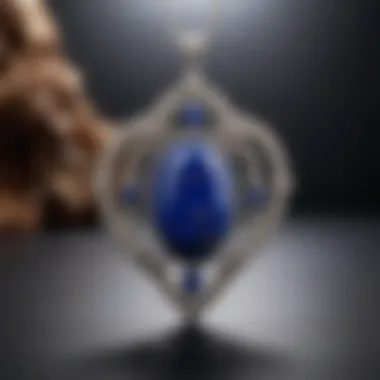Exploring the Deep Significance of Lapis Lazuli


Intro
Lapis lazuli, a mesmerizing deep blue stone, has captured hearts and minds throughout history. This beautiful gemstone is more than just a striking ornament; it is laden with rich meanings and captivating stories from different cultures across the globe. In this exploration, we will unveil the layers of significance attached to lapis lazuli and its journey from the Earth’s crust to the realm of spirituality and artistry.
Lapis lazuli is primarily composed of lazurite, along with calcite, sodalite, and pyrite. This stunning composition creates its distinctive azure hue, often scattered with flashes of gold from pyrite, which some have poetically compared to a starry night sky. Such a remarkable appearance is not what makes lapis lazuli special; instead, its historical and spiritual significance throughout various civilizations lends it a depth that resonates with gemstone enthusiasts and collectors alike.
Now, let’s delve deeper into the intricate world of lapis lazuli, beginning with an overview that sheds light on the essence of gemstones.
Prolusion to Lapis Lazuli
Lapis lazuli is more than a mere gemstone; it’s a vibrant narrative pulsating with history, spirituality, and artistry. Embedded in the fabric of ancient civilizations, the deep blue hue of this stone has served many roles, from royal adornment to a tool for introspection. In this section, we set the stage for understanding its significance across various domains, both historical and modern.
The allure of lapis lazuli lies in its vivid color, reminiscent of a clear night sky studded with stars. This gemstone has enchanted many, serving as a bridge connecting us to our past. Throughout this article, we will explore how lapis lazuli has been cherished for its physical beauty, but also for the profound meaning it carries.
Examining the history, properties, and contemporary relevance of lapis lazuli reveals not just facts but rather an intricate tapestry that weaves together culture, art, and human emotion. Grasping these concepts is essential for anyone looking to appreciate this gemstone in depth.
Defining Lapis Lazuli
Lapis lazuli is primarily comprised of lazurite, a mineral that grants it that sought-after azure color. It can also contain small amounts of other minerals like calcite, pyrite, and sodalite, which can either accentuate its beauty or alter its appearance—making each stone somewhat unique. The common association with the color blue makes lapis lazuli stand out from other gemstones. Its historical and cultural significance underlines its worth beyond mere aesthetics.
The term "lapis lazuli" stems from Latin and Persian roots meaning "blue stone." Its usage spans through millennia, transcending various civilizations—each placing its own value on this captivating mineral.
Historical Context
Ancient Civilizations and Lapis Lazuli
In ancient times, lapis lazuli was much more than a decorative item; it held a hallowed place among gemstones. The Egyptians, for instance, considered it a stone of protection and wisdom. It was often included in tombs, believing it would aid the deceased in their journey to the afterlife. This stone found its way into the hearts and rituals of various cultures, each believing it held a piece of divine insight.
Lapis lazuli’s significance is not just limited to Egypt. In the Mesopotamian civilizations, for instance, the stone was associated with the gods and was believed to protect against evil spirits. Their use of lapis lazuli in amulets and seals illustrates its sacred connotation, making it more than just a precious stone—it was a talisman of sorts.
Such reverence for lapis lazuli shows its continued appeal and importance today. Being intertwined with the narratives of ancient people offers a profound dimension to those who appreciate not just its beauty but what it represents.
Historical Artifacts Featuring Lapis Lazuli
Numerous artifacts showcase the enduring legacy of lapis lazuli throughout history. The mask of Tutankhamun, for instance, incorporates lapis lazuli as part of its intricate design, housing a mesmerizing beauty that has captivated audiences for ages. This specific artifact highlights the stone’s pivotal role in portraying power and wealth, further making a statement about its esteemed place in ancient Egyptian and broader global history.
From decorative jewelry to significant ceremonial items, the presence of lapis lazuli in ancient artifacts serves as a testament to its multifaceted applications. Each piece, rich with cultural significance, offers viewers a glimpse into the values and beliefs of the societies that cherished them. This adds a layer of authenticity and emotional weight that enhances its intrinsic worth as a gemstone.
Thus, lapis lazuli exemplifies not only a decorative luxury but also a meaningful symbol connecting history with modernity. Engaging with its past provides a greater appreciation for its authentic beauty—further establishing its role as a cornerstone of cultural narrative.
Geological Characteristics
The geological features of lapis lazuli are crucial to understanding not just how the stone came to be, but also what gives it the distinct beauty and value that enthusiasts cherish. This section explores the formation and sources of lapis lazuli, presenting a detailed view of its physical characteristics and how these factors contribute to its prominence in jewelry and collectibles.
Formation of Lapis Lazuli
Lapis lazuli forms primarily from metamorphic processes. This beautiful stone originates when limestone undergoes metamorphism, particularly as it interacts with other gemstones and minerals, such as pyrite and calcite. The key component of lapis lazuli is lazurite, which imbues the stone with its characteristic deep blue color.
During its formation, the conditions must be just right—meaning the right heat and pressure are crucial for creating the unique crystalline structure that results in lapis lazuli. Notably, this rock often has smaller flecks of gold, the pyrite, that spark against the rich blue, presenting an attractive visual contrast as well as illustrating its complex geological journey. The process can take millions of years, reflecting nature's slow artistry.
Sources of Lapis Lazuli
Lapis lazuli is primarily mined in a few specific regions around the world, each known for producing stones of varying quality and color intensity. The most notable sources are Afghanistan, Chile, and Russia. These locations not only yield high-quality lapis but also contribute to the cultural lore surrounding the gem.


Major Mining Regions
The ancient mines located in Afghanistan, particularly in the Badakhshan province, have been the heart of lapis lazuli production for over 6,000 years. This region is renowned for its rich deposits, offering stones with a vibrant hue and minimal calcite inclusions, which makes them highly sought after in markets around the globe.
The unique feature of this area stems from its historical significance. Badakhshan's lapis lazuli was traded along the famed Silk Road, which facilitated cultural exchanges and elevated the stone's status as a luxury item. The challenges of mining in this remote region often mean that only the most committed miners extract the stone, thus ensuring a certain quality. In contrast, Chilean deposits may yield gems that are more accessible but often lack the deep color found in their Afghan counterparts.
Quality and Grades of Lapis Lazuli
When discussing the quality and grades of lapis lazuli, several factors come into play, including color saturation, the presence of other minerals, and clarity. High-quality lapis is a deep, rich blue with minimal white calcite or golden pyrite specks. This prominence of blue is key to its popularity, as it reflects the stone's connection to royalty and wisdom.
The beneficial aspect of understanding quality is that it allows collectors and designers to select more meaningful pieces. Poorer quality stones, while still attractive, may exhibit less desirable characteristics, such as excessive calcite or muted tones. Some modern gemologists even classify lapis lazuli into grades, with AA being the finest and A being the most accessible.
In summary, the geological characteristics of lapis lazuli encompass much more than its visual appeal. By comprehending its formation and geographic sources, gem lovers can appreciate the intricate details that contribute to the value and significance of lapis lazuli in both historical and contemporary contexts.
Cultural Significance
Understanding the cultural significance of lapis lazuli offers a deeper insight into its vibrant past and the ongoing relevance it holds in various contexts today. This stone is more than just a pretty face; it has been interwoven into the tapestry of cultures around the world, making its mark in art, religion, and social status. With its rich, azure hue reminiscent of the heavens, lapis lazuli has often symbolized deeper meanings that are profoundly impactful.
Lapis Lazuli in Ancient Egypt
In Ancient Egypt, lapis lazuli was more than just a jewel; it was considered a gateway to the divine. This gemstone was often associated with the gods, most notably with Isis and Osiris. Pharaohs and high priests adorned themselves with lapis lazuli as a symbol of power and protection, believing it conferred wisdom and insight. It wasn't uncommon to find this stone in burial artifacts, suggesting a belief it would guide the deceased in the afterlife.
Lapis lazuli's popularity during this period can be attributed to its rarity and striking appearance. The stone was imported from far-flung regions, often traded for its weight in gold, which further entrenched its status as a luxury item. By studying ancient artifacts, one can see how lapis lazuli emerged as a cornerstone in funerary practices, emphasizing the unyielding connection the Egyptians held with both the sacred and the material world.
Symbolism in Various Cultures
Lapis Lazuli in the Middle Ages
During the Middle Ages, lapis lazuli made its way into religious art and manuscripts, particularly in Europe. Artists crushed this gemstone into a fine powder to create ultramarine pigment, a prized color used in illuminating texts and painting religious figures. This application carries a significant layer of meaning; ultramarine was often reserved for representing divine subjects due to its expense and beauty. It was a way for artists to elevate their work, literally using the stone's rich symbolism as a tool to convey sanctity.
The key characteristic of lapis lazuli during this time was its association with divinity and wisdom. Access to ultramarine was limited, making it an elite choice, much like how royalty often chose lapis lazuli to signify their elevated status. Those who could afford such luxurious materials were often able to elevate their messages and artwork to a level of greater theological importance.
Some drawbacks, however, arose from its cost and accessibility. Not every artist could afford to use ultramarine, leading to a disparity in artistic capabilities dependent on wealth. However, this very exclusivity helped cement lapis lazuli's status as a symbol of prestige and reverence within the art of the period.
Eastern Interpretations
In Eastern cultures, specifically in Persian and Indian traditions, lapis lazuli has been treasured for centuries, primarily for its spiritual attributes. It is seen as a stone of truth, enhancing one's insights and facilitating clear thought. This aligns with the broader symbolism of the stone as a harbinger of tranquility and harmony, resonating deeply with practitioners of meditation and mindfulness. The unique feature here is its psychological benefits; many believe that wearing lapis lazuli can bring peace of mind and help to navigate complex emotional landscapes.
These Eastern interpretations present an alternative view of its significance relative to Western lenses. Where Western cultures may view lapis with a focus on status and power, Eastern perspectives embrace its healing properties and its role in spiritual practices. In this way, lapis lazuli serves as a bridge across cultures; it connects different worldviews while consistently embodying values like clarity, wisdom, and serenity.
"Lapis lazuli is not just a stone; it embodies a myriad of meanings across cultures and eras. Through its rich history, it bridges the material and the spiritual, showcasing its profound significance."
In summary, the lapis lazuli’s journey through various cultures highlights its multifaceted symbolism. It has transcended mere decorative use to become a powerful emblem of spiritual and social significance, deeply influencing both ancient and contemporary practices.
Metaphysical Properties
The metaphysical properties of lapis lazuli have fascinated people for centuries. This stone is believed to carry a certain kind of energy that resonates with the mind and spirit. Many enthusiasts describe lapis lazuli as more than just a beautiful gem; they regard it as a tool for personal growth and spiritual enhancement. In various spiritual circles, it’s considered a bridge to higher consciousness, helping users delve deeper into self-awareness and enlightenment. Let’s explore the specific components of these metaphysical properties.
Healing Attributes
When it comes to healing, lapis lazuli is often associated with physical well-being. Its deep blue color is said to reflect calmness and tranquility, promoting a sense of peace within both body and mind. Practitioners of crystal healing believe that wearing or holding lapis lazuli can help alleviate issues ranging from headaches to respiratory problems. Its purported ability to enhance the immune system and detoxify the body adds to its charm as a healing stone.
Notably, lapis lazuli is said to activate the throat chakra, facilitating better communication and clearer expression of thoughts and feelings. This aspect is particularly significant for those who struggle with public speaking or emotional expression. The stone’s healing properties make it a popular choice in holistic practices, where it is believed to assist in emotional and physical healing journeys.
Psychological Benefits


Clarity of Thought
Clarity of thought revolves around the ability to think clearly and make well-informed decisions. Lapis lazuli is often celebrated for its role in unlocking this mental clarity. It is believed to sharpen intellectual capacity and stimulate the mind, making it easier for individuals to process information and understand complex ideas. This stone can be particularly beneficial for students or anyone engaged in critical thinking or creative endeavors.
The key characteristic of clarity of thought associated with lapis lazuli lies in its calming energy, which promotes stress relief and helps quell distractions. This unique feature enables users to maintain focus on their tasks, thereby allowing them to explore their thoughts more profound and effectively. Many believe that integrating lapis lazuli into their daily routines can foster a more organized thought process and enhance overall mental performance.
Emotional Balance
Emotional balance is another potent psychological benefit linked to lapis lazuli. This stone is thought to stabilize emotions, making it especially valuable for individuals facing trials or turbulent periods in their lives. The soothing presence of lapis lazuli is said to alleviate feelings of anxiety and frustration, generating a serene aura around the user.
The hallmark of emotional balance facilitated by lapis lazuli is its ability to encourage self-reflection while promoting acceptance of one’s feelings. Its unique feature lies in fostering tranquility that allows a person to confront their emotions without feeling overwhelmed. In a world where emotional chaos often reigns, incorporating lapis lazuli into one’s life can serve as a protective buffer, enhancing well-being while navigating daily challenges.
"Lapis lazuli: where clarity meets balance. A true companion on the journey to self-discovery."
Ultimately, the metaphysical properties of lapis lazuli make it a powerful ally for both mental clarity and emotional stability, appealing to those who seek depth and refinement in their lives.
Symbolism of Lapis Lazuli
Lapis Lazuli is not just a beautiful gemstone but is steeped in deep symbolism. Often regarded as a bridge between the earthly and the divine, this striking blue stone holds meanings that transcend cultures and centuries. Its symbolism resonates with themes such as royalty, power, and spiritual enlightenment, making it a focal point in various societies.
Connection to Royalty and Power
The history of Lapis Lazuli is closely intertwined with the concept of authority and influence. In ancient civilizations, notably in Egypt, it was a prized possession among the elite. Pharaohs adorned themselves with lapis lazuli, believing that this striking stone could ward off evil spirits and enhance their power. The association of lapis lazuli with royalty can be seen in artifacts such as burial masks and tomb decorations where the stone was used for its lush azure color.
- Royal Emblems: Kings and queens often had lapis lazuli carved into their insignia, reinforcing their connection to the divine.
- Art and Artifacts: The stone has been found in significant historical pieces, like the famous Tutankhamun's mask, where it is embedded around the eyes, adding to the regal connotation.
In cultures around the globe, lapis lazuli has represented not just wealth but also wisdom and virtue. For instance, in ancient Persia, it was believed to symbolize justice and truth. When worn, it was thought to represent a brilliant light of insight, giving the wearer the ability to see things clearly. As such, lapis lazuli became more than a decorative gem; it transformed into an emblem of wisdom and authority.
Spiritual Enlightenment
Another vital aspect of lapis lazuli's symbolism is its connection to spiritual understanding and enlightenment. People have utilized this stone in different metaphysical practices over the years. It has frequently been seen as a stone that can enhance introspection and help in the pursuit of spiritual truth.
- Introspection: Lapiz lazuli is often heralded for its capability to promote self-awareness. It aids individuals in exploring their thoughts and emotions, guiding them toward clarity.
- Spiritual Journeys: In many healing traditions, lapis lazuli is utilized to facilitate astral travel and meditation, enabling practitioners to connect with the higher realms of consciousness.
For some, the deep blue color of lapis lazuli is akin to the vastness of the sky or the deep ocean, symbolizing the endless quest for enlightenment. When used during meditation, it can help quiet the mind and create a deeper understanding of life’s mysteries.
"Lapis lazuli is a tool in itself, a medium through which the wearer can channel their thoughts, emotions, and spiritual energies."
Overall, lapis lazuli not only serves as a beacon of beauty but also functions as a powerful symbol connecting us to higher truths, deep wisdom, and the legacies of those who walked the Earth before us. Its significance continues to inspire gem enthusiasts, collectors, and spiritual seekers alike.
Contemporary Usage
When it comes to lapis lazuli, the modern world has embraced this stone with open arms. Its uses today extend beyond mere aesthetics, weaving its way into everyday life and practices that honor both tradition and style.
Lapis Lazuli in Jewelry
Trends in Gemstone Jewelry
Lapis lazuli has become a trendy choice in the realm of gemstone jewelry. People gravitate towards its vibrant blue color and gold flecks, often seen in rings, necklaces, and bracelets. This stone's popularity is rooted in its ability to evoke a sense of elegance while being accessible at various price points. As fashion trends evolve, lapis lazuli maintains its relevance, captivating those who seek both beauty and meaning in their accessories.
- Key Characteristics: The intense blue hue marked by specks of gold or white calcite makes lapis a favorite among jewelers and buyers alike.
- Benefits: Its striking appearance draws attention, making it a conversation starter. Furthermore, owning lapis lazuli jewelry can signify sophistication and a connoisseur’s taste.
- Unique Features: Lapis can elevate minimalist designs, blending well with both casual and formal attire.
However, trends come and go. While lapis lazuli enjoys its moment, it is important to choose designs that stand the test of time rather than those that may soon fall out of favor.


Designs Incorporating Lapis Lazuli
Incorporating lapis lazuli into jewelry designs offers a unique flair. From bohemian styles to classic designs, lapis is adaptable. Craftsmen and designers are now combining it with other gemstones and metals, creating a stunning visual contrast and enriching the piece's significance.
- Key Characteristics: The ability to pair well with both gold and silver nullifies the concern of mismatch in choice of metal, making it a versatile selection.
- Benefits: Lapis lazuli can symbolize deeper meanings in jewelry, such as wisdom and self-awareness, appealing to buyers who wish to carry such sentiments.
- Unique Features: Designs range from intricate settings to simple, minimalist styles that allow the stone's natural beauty to shine.
Yet, with versatility comes responsibility. Not every design honors the stone's rich history and significance, so discerning buyers should be cautious about the stories behind the designs they choose to wear.
Collecting Lapis Lazuli
Delving into the world of lapis lazuli collecting is an enriching journey. As collectors begin, there are critical aspects to consider for building a meaningful collection.
Valuation and Authentication
Understanding valuation and authentication is vital for any collector. Being able to assess the quality of lapis lazuli determines both its monetary and emotional worth. Factors like color saturation, the presence of gold pyrite, and the stone's overall condition play a significant role in its assessment.
- Key Characteristics: Authentic lapis lazuli showcases a vibrant color with a vivid blue tone complemented by golden specks.
- Benefits: Authentic pieces often hold their value better over time, making them a more desirable investment.
- Unique Features: Lack of treatment or inauthentic materials can significantly drop value, hence authentication is paramount.
Collectors should always seek out trusted sources to avoid being taken for a ride in what can be a tumultuous market.
How to Start a Collection
Starting a lapis lazuli collection can feel daunting, but with a little guidance, it becomes quite an exciting venture. Setting personal goals and understanding individual tastes is crucial in the initial stages.
- Key Characteristics: A focused approach, whether by style, origin, or type, can lead to a more fulfilling collection.
- Benefits: Collecting can connect you with a community of gemstone enthusiasts and like-minded individuals who share insights and connections.
- Unique Features: Begin with smaller, affordable pieces before investing in high-value items. This way, you can develop your eye for quality and authenticity without breaking the bank.
Caring for Lapis Lazuli
Maintaining lapis lazuli is not just about preserving its beauty; it's about respecting the rich history and cultural significance that the stone carries. This gemstone, famed for its royal blue color and specks of golden pyrite, has been a treasured artifact across ages and civilizations. Proper care ensures that lapis lazuli remains a centerpiece in jewelry and collections, reflecting its timeless allure.
Cleaning Techniques
When it comes to cleaning lapis lazuli, simplicity is the name of the game. Below are effective steps to keep your lapis lazuli looking its best:
- Gentle Wipe: Use a soft, lint-free cloth for regular cleaning. This removes dust and fingerprints without scratching its surface.
- Avoid Water: Unlike some gemstones, lapis lazuli requires extra care when it comes to water. Avoid soaking it in water, as prolonged exposure can lead to discoloration.
- Mild Soap Option: If you need a deeper clean, dampen the cloth slightly with lukewarm water mixed with mild soap. Ensure that the cloth is not wet but just damp. After cleaning, gently dry the stone with another cloth.
"The care you give to your lapis lazuli speaks volumes about your appreciation of its heritage."
Storage Recommendations
Storing lapis lazuli correctly will also help in maintaining its charm. Here are some recommendations to consider:
- Separate Compartments: When storing lapis lazuli jewelry, keep it in a separate compartment of a jewelry box or a soft pouch. This prevents it from scratching against other stones and metals.
- Avoid Direct Sunlight: Prolonged exposure to direct sunlight can fade its vibrant color. Store it in a cool, dark place.
- Temperature Considerations: Lapis lazuli is sensitive to heat. Ensure that the storage area does not experience drastic temperature changes, as this can lead to cracking over time.
Taking these measures will help your lapis lazuli retain its striking appearance and protect its historical implications, ensuring that it remains not only beautiful but also meaningful.
End
To bring together the multitude of insights presented on lapis lazuli, it's clear that this stone is more than just a pretty face. It embodies a legacy that stretches back across millennia, touching the realms of art, spirituality, and human connection. As explored thoroughly throughout this article, lapis lazuli's historical significance particularly resonates with its ties to power and divinity. The stone's vibrant blue hue has signified royalty and spiritual insight, serving as a symbol of greatness for various civilizations.
The Lasting Legacy of Lapis Lazuli
The legacy of lapis lazuli remains ever potent. Many cultures deemed it an important part of their aesthetics and rituals. In ancient Egypt, for instance, lapis lazuli was often associated with the gods. It was a staple in tomb decorations and jewelry, believed to bestow protection and wisdom on the deceased. This relationship with the divine illustrates how deeply lapis lazuli transcends being merely a gemstone.
Today, its legacy carries over into modern spirituality, with many people still believing in its healing properties. Whether it's worn as jewelry or placed in a collection, the stone serves as a touchstone for introspection and clarity. Collectors appreciate not just its beauty but its historical and cultural significance as well.
Reflections on its Significance
Reflecting on lapis lazuli invites a contemplation of personal and collective journeys. For gem enthusiasts and collectors, the stone's historical context offers profound insights into the interactions between culture and place over time. Lapis lazuli's journey from the mines in Afghanistan to ancient royal tombs illustrates the connections drawn between people, earth, and spirit.
Moreover, the symbolism surrounding lapis lazuli speaks to its role in one’s personal journey toward enlightenment and emotional clarity. Many still turn to this gemstone during times of crisis, seeking its assistance in navigating complex emotional waters. The significant traits associated with lapis lazuli suggest that it's not just an adornment but a vehicle for personal growth and understanding.



